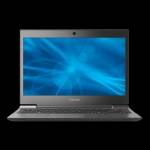The promises from Intel on the week before CES 2012 in Las Vegas speak of a device that’s as lightweight as a tablet, but that has the full keyboard users require to do real-world work, and the Windows 8 operating system they need for their everyday software. It’s a “tablet plus,” if you will. But will you really be able to touch an ultrabook’s screen the same way you would a tablet’s screen?

A statement this morning from Synaptics, the principal maker of touchpads for notebook computers, reveals that many of the spotlighted PCs with Intel’s new ultrabook form factor will indeed be multitouch, but not on the screen. Although Synaptics does make capacitative touchscreen control chips, the older, separate touchpad units remain Synaptics’ bread-and-butter. And that affects two components of the overall form factor that could impact consumers’ comparisons of ultrabooks with tablets like Apple’s iPad: size and weight.
As Intel rolls out “phase 2” of its Ultrabook (capital “U”) adoption guidelines for this year, it specifies the use of Intel’s own integrated HD graphics processors. That compels manufacturers such as HP, Acer, and Toshiba to build systems with bigger screens in the 16:9 aspect ratio that consumers expect with “HD” video. Although the iPad is marketed as the perfect device for remote streaming video, its 7.31″ x 9.5″ size means HD video requires letterboxing, the lack of which is supposed to be one of the Intel form factor’s key advantages.
So ultrabook screens must be wide by definition. The inclusion of a Synaptics touchpad in addition to the wide screen will make the 2012 round of ultrabooks big – perhaps too big for consumers to consider them in the same league with tablets. For example, HP’s first ultrabook – its recently released Folio 13 – is 8.67 inches tall, incorporating the combined height of the keyboard and the touchpad below it. To accommodate the HD aspect ratio, though, it becomes 12.54 inches wide – more than an ordinary sheet of typing paper, which is the usual benchmark for a “tablet” form factor.
And though ultrabooks will be marketed as lightweight, that measurement will no doubt be in comparison to typical notebook PCs – many of which are actually no larger. The Folio 13 will be 3.3 pounds, according to HP specs. An iPad, by comparison, weighs just 1.33 pounds.
Three years ago, during the nadir of the last economic downturn, the netbook form factor helped rescue an ailing PC industry. Intel was reluctant to acknowledge that fact until at least a whole year later. Many netbooks were based on the first single-core Intel Atom processors. They too had touchpads. But these early netbooks weren’t beholden to a manufacturer’s standard, in order to qualify for a certification program (today’s Intel Ultrabook program uses the word “inspired” rather than “certified”). So a standard setter like the Asus Eee PC 701 could feature a 7-inch diagonal screen with 800 x 480 resolution, and fold up to 6.5″ x 8.9″ – smaller than today’s iPad.
By comparison, HP’s Folio 13 has a 13.3″ diagonal screen. Among the other ultrabook models Synaptics mentioned today: Acer’s Aspire S3-951 series (right), also available now, measures 8.6″ x 12.7″ with a 13.3″ diagonal screen; Lenovo’s u300s measures 8.5″ x 12.75″ with a 13.3″ diagonal; and Toshiba Portege Z830 (shown in the video above) measures 9″ x 12.44″ with a 13.3″ diagonal screen. Synaptics today mentions Intel’s minimum target screen size of 11.1 inches, and its upper bounds of about 13 inches. If you were to shrink these “stage 2″ ultrabooks for Intel’s lower screen bounds, and still leave room for the touchpad, the resulting size would still be close to 8″ x 11.5” – still just beyond the target typing paper benchmark for a tablet.

This matters to the accessories market, which has already seen a resurgence thanks to the iPad, Amazon Kindle, B&N Nook, and Samsung Galaxy Tab. No matter how thin an ultrabook becomes (expect thinner than 0.75″), there’s an entire market catering to scholars that won’t take it seriously unless it scales down to legal pad-size or below. What’s more, consumers may – even subconsciously – conclude ultrabooks are less practical than tablets with respect to portability. During the (brief) heyday of the netbook, consumers stated size was at least as important to their purchasing decision as price. Intel may need to consider this fact before it creates the next great novelty form factor, and perhaps put some of that $300 million ultrabook fund toward expediting the development of touchscreens.






